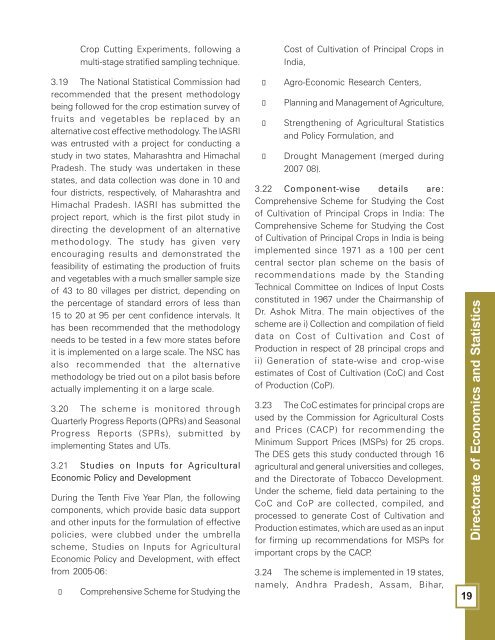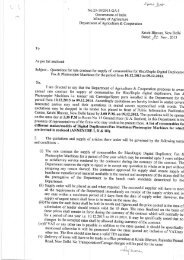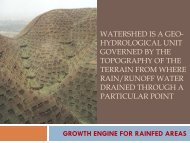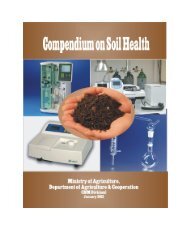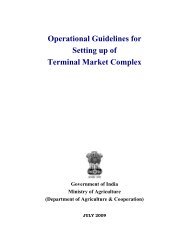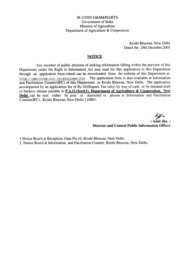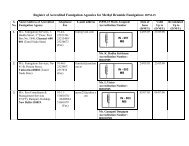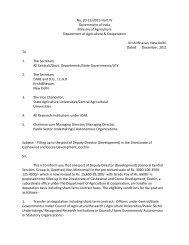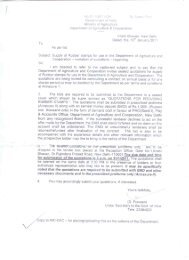Annual Report 2009-2010 - Department of Agriculture & Co-operation
Annual Report 2009-2010 - Department of Agriculture & Co-operation
Annual Report 2009-2010 - Department of Agriculture & Co-operation
You also want an ePaper? Increase the reach of your titles
YUMPU automatically turns print PDFs into web optimized ePapers that Google loves.
Crop Cutting Experiments, following a<br />
multi-stage stratified sampling technique.<br />
3.19 The National Statistical <strong>Co</strong>mmission had<br />
recommended that the present methodology<br />
being followed for the crop estimation survey <strong>of</strong><br />
fruits and vegetables be replaced by an<br />
alternative cost effective methodology. The IASRI<br />
was entrusted with a project for conducting a<br />
study in two states, Maharashtra and Himachal<br />
Pradesh. The study was undertaken in these<br />
states, and data collection was done in 10 and<br />
four districts, respectively, <strong>of</strong> Maharashtra and<br />
Himachal Pradesh. IASRI has submitted the<br />
project report, which is the first pilot study in<br />
directing the development <strong>of</strong> an alternative<br />
methodology. The study has given very<br />
encouraging results and demonstrated the<br />
feasibility <strong>of</strong> estimating the production <strong>of</strong> fruits<br />
and vegetables with a much smaller sample size<br />
<strong>of</strong> 43 to 80 villages per district, depending on<br />
the percentage <strong>of</strong> standard errors <strong>of</strong> less than<br />
15 to 20 at 95 per cent confidence intervals. It<br />
has been recommended that the methodology<br />
needs to be tested in a few more states before<br />
it is implemented on a large scale. The NSC has<br />
also recommended that the alternative<br />
methodology be tried out on a pilot basis before<br />
actually implementing it on a large scale.<br />
3.20 The scheme is monitored through<br />
Quarterly Progress <strong>Report</strong>s (QPRs) and Seasonal<br />
Progress <strong>Report</strong>s (SPRs), submitted by<br />
implementing States and UTs.<br />
3.21 Studies on Inputs for Agricultural<br />
Economic Policy and Development<br />
During the Tenth Five Year Plan, the following<br />
components, which provide basic data support<br />
and other inputs for the formulation <strong>of</strong> effective<br />
policies, were clubbed under the umbrella<br />
scheme, Studies on Inputs for Agricultural<br />
Economic Policy and Development, with effect<br />
from 2005-06:<br />
<strong>Co</strong>mprehensive Scheme for Studying the<br />
<strong>Co</strong>st <strong>of</strong> Cultivation <strong>of</strong> Principal Crops in<br />
India,<br />
Agro-Economic Research Centers,<br />
Planning and Management <strong>of</strong> <strong>Agriculture</strong>,<br />
Strengthening <strong>of</strong> Agricultural Statistics<br />
and Policy Formulation, and<br />
Drought Management (merged during<br />
2007 08).<br />
3.22 <strong>Co</strong>mponent-wise details are:<br />
<strong>Co</strong>mprehensive Scheme for Studying the <strong>Co</strong>st<br />
<strong>of</strong> Cultivation <strong>of</strong> Principal Crops in India: The<br />
<strong>Co</strong>mprehensive Scheme for Studying the <strong>Co</strong>st<br />
<strong>of</strong> Cultivation <strong>of</strong> Principal Crops in India is being<br />
implemented since 1971 as a 100 per cent<br />
central sector plan scheme on the basis <strong>of</strong><br />
recommendations made by the Standing<br />
Technical <strong>Co</strong>mmittee on Indices <strong>of</strong> Input <strong>Co</strong>sts<br />
constituted in 1967 under the Chairmanship <strong>of</strong><br />
Dr. Ashok Mitra. The main objectives <strong>of</strong> the<br />
scheme are i) <strong>Co</strong>llection and compilation <strong>of</strong> field<br />
data on <strong>Co</strong>st <strong>of</strong> Cultivation and <strong>Co</strong>st <strong>of</strong><br />
Production in respect <strong>of</strong> 28 principal crops and<br />
ii) Generation <strong>of</strong> state-wise and crop-wise<br />
estimates <strong>of</strong> <strong>Co</strong>st <strong>of</strong> Cultivation (<strong>Co</strong>C) and <strong>Co</strong>st<br />
<strong>of</strong> Production (<strong>Co</strong>P).<br />
3.23 The <strong>Co</strong>C estimates for principal crops are<br />
used by the <strong>Co</strong>mmission for Agricultural <strong>Co</strong>sts<br />
and Prices (CACP) for recommending the<br />
Minimum Support Prices (MSPs) for 25 crops.<br />
The DES gets this study conducted through 16<br />
agricultural and general universities and colleges,<br />
and the Directorate <strong>of</strong> Tobacco Development.<br />
Under the scheme, field data pertaining to the<br />
<strong>Co</strong>C and <strong>Co</strong>P are collected, compiled, and<br />
processed to generate <strong>Co</strong>st <strong>of</strong> Cultivation and<br />
Production estimates, which are used as an input<br />
for firming up recommendations for MSPs for<br />
important crops by the CACP.<br />
3.24 The scheme is implemented in 19 states,<br />
namely, Andhra Pradesh, Assam, Bihar,<br />
Directorate <strong>of</strong> Economics and Statistics<br />
19


